Birds are integral to the natural beauty of the landscape in Niedersachsen, Germany. The state has many species, ranging from colorful songbirds to large raptors.
Over 400 species of birds have been recorded in the state, making it a paradise for birdwatchers and nature enthusiasts. With its diverse habitats, Niedersachsen provides an ideal environment for a wide range of birds, making it a great place to go bird-watching.
From the Elbe’s wetlands to the Harz mountains, the state has something to offer for everyone. Whether you are a beginner or an experienced birder, Niedersachsen will indeed have something to offer.
24 Birds to Watch in Niedersachsen
Niedersachsen is a state in northern Germany that offers a rich diversity of birdlife. Whether you are a beginner or an expert, you will find plenty of opportunities to enjoy this region’s beauty and variety of birds.
Here are 24 birds that you should not miss when visiting Niedersachsen.
1. Eurasian Black Grouse
The black grouse is a game bird species belonging to the grouse family. It is found in the Palearctic region, meaning it is distributed across northern Europe and Asia.
It is a sedentary species, meaning it does not migrate, and it can be found in moors and steppes when it is breeding. These habitats are usually situated near wooded areas, which shelter the grouse.
The black grouse is also known as the northern black grouse, Eurasian black grouse, blackgame, or blackcock. It is a large bird with mottled brown and black plumage. It is mainly a ground-dwelling species and feeds on various plants and insects.
Its main predators are foxes, corvids, and raptors. Although the black grouse is not considered endangered, its population has decreased recently due to human disturbance in its habitats.
Conservation measures have been implemented to help the species, including creating protected areas and controlling hunting activities.
| Kingdom | Animalia |
| Phylum | Chordata |
| Class | Aves |
| Order | Galliformes |
| Family | Phasianidae |
| Genus | Lyrurus |
| Species | L. tetrix |
2. Mallard
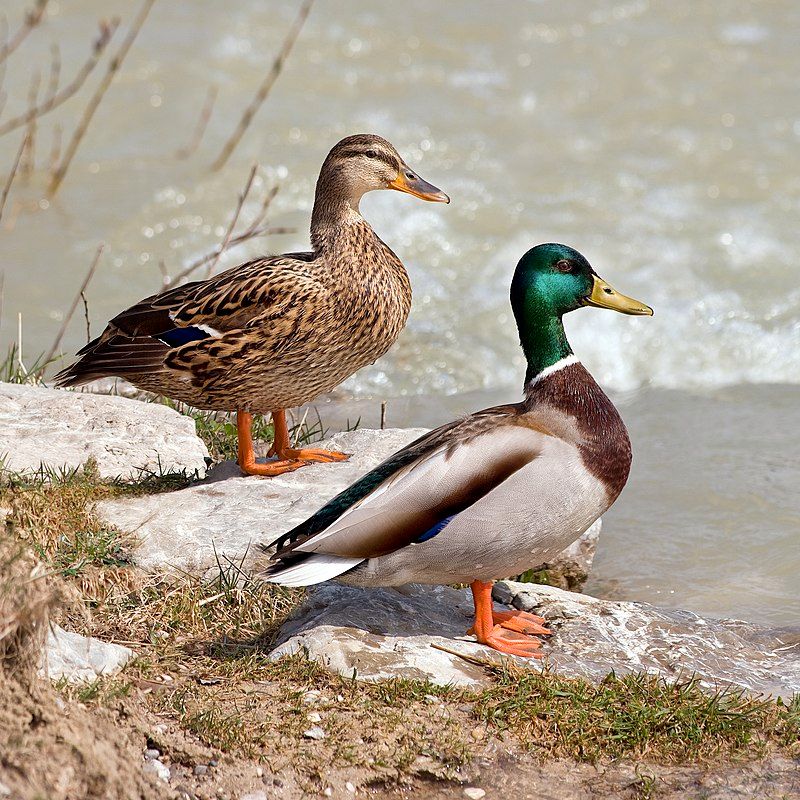
The mallard or wild duck is a dabbling duck with a wide geographical range across the temperate and subtropical regions of the world. It has a native habitat in the Americas, Eurasia, and North Africa.
Furthermore, it has been introduced to places outside its native range, including New Zealand, Australia, Peru, Brazil, Uruguay, Argentina, Chile, Colombia, the Falkland Islands, and South Africa.
This is likely due to human activities such as introducing domestic ducks, which have allowed the mallard to establish itself in new environments. The mallard is an adaptable species, able to thrive in various environments, from wetlands and grasslands to urban areas.
It is also a famous game bird and is widely hunted worldwide. This species is a critical component of many ecosystems, providing food for other animals and helping to disperse seeds and nutrients within the environment.
It is also an important species for conservation, as it is a symbol of wetlands, and its presence is often used as an indicator of wetland health.
| Kingdom | Animalia |
| Phylum | Chordata |
| Class | Aves |
| Order | Anseriformes |
| Family | Anatidae |
| Genus | Anas |
| Species | A. platyrhynchos |
3. Common Crane
The standard crane is a species of bird belonging to the family Gruidae, known as cranes. It is a medium-sized bird and is the only crane widely found in Europe, apart from the demoiselle crane and the Siberian crane.
The latter two species can be found regularly in the far eastern part of the continent. The standard crane is a migratory species seen in many parts of Europe, especially during the summer breeding season.
It is an important species for conservation efforts, as it indicates the health of the ecosystems in which it is found. Its presence is also seen as a sign of good luck in many cultures, with the bird associated with long life and fertility.
| Kingdom | Animalia |
| Phylum | Chordata |
| Class | Aves |
| Order | Gruiformes |
| Family | Gruidae |
| Genus | Grus |
| Species | G. grus |
4. Eurasian Collared Dove
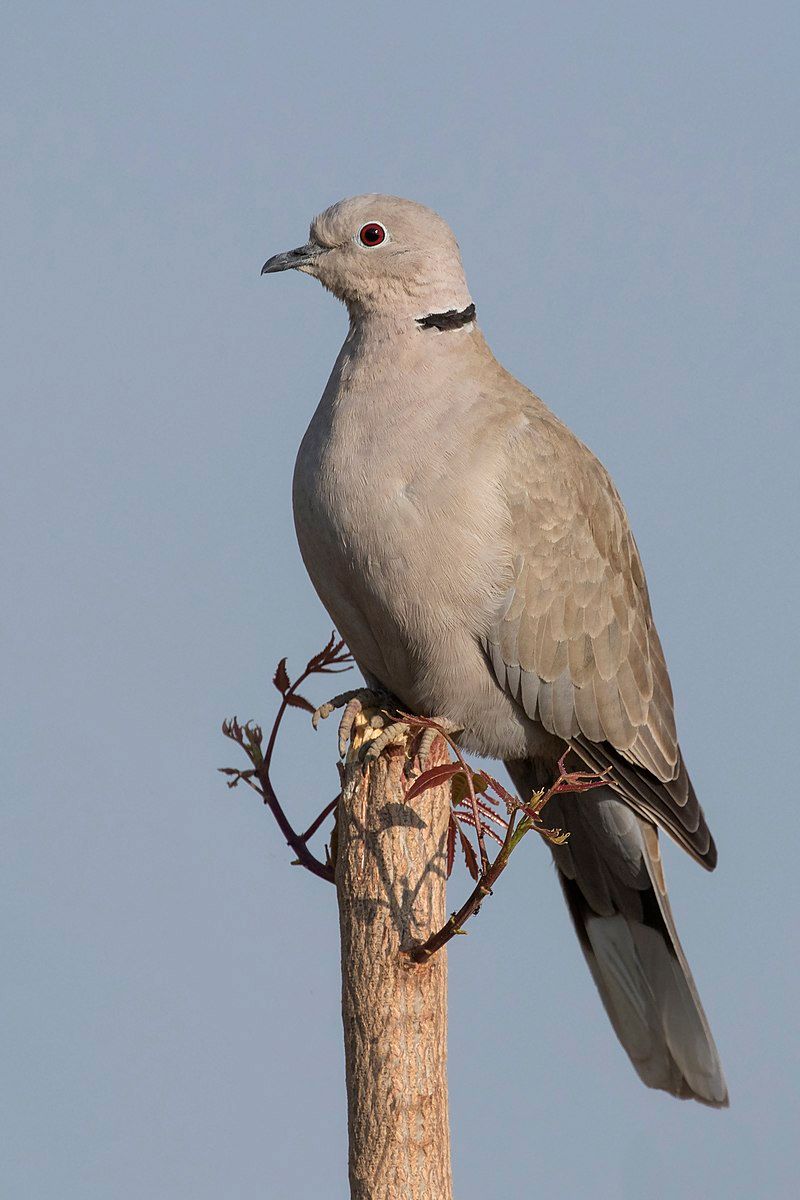
The Eurasian collared dove is a species of dove that is native to both Europe and Asia. This dove species was introduced to other places, including Japan, North America, and the Caribbean.
Its wide range and increasing population have caused it to be listed on the IUCN Red List as Least Concern since 2014.
This means the species is not in danger of becoming extinct, and the population is stable and rising. The Eurasian collared dove is a species that adapts very well to different environments.
It can be found in various habitats, including grasslands, farms, and urban areas. This adaptability has enabled the species to thrive in many different places and has helped it to spread to new areas.
The omnivorous species feeds on various foods, including grain, fruits, and insects. The Eurasian collared dove is a species of great interest to birdwatchers and researchers.
It is a long-distance migratory bird whose movements can be tracked yearly. It is also a species of conservation concern due to its high numbers and wide range.
Researchers are studying the behavior of the species in different areas and how it affects other species in its range. The Eurasian collared dove is a species that has a broad global range and a growing population.
It has been listed as Least Concern on the IUCN Red List since 2014, and its adaptability and ability to thrive in various habitats has helped it spread to new areas.
It is an exciting species of great interest to birdwatchers and researchers, and its movements are monitored yearly. Its high numbers and wide range make it a species of conservation concern, and researchers study its behavior in different areas.
| Kingdom | Animalia |
| Phylum | Chordata |
| Class | Aves |
| Order | Columbiformes |
| Family | Columbidae |
| Genus | Streptopelia |
| Species | S. decaocto |
5. Black Stork
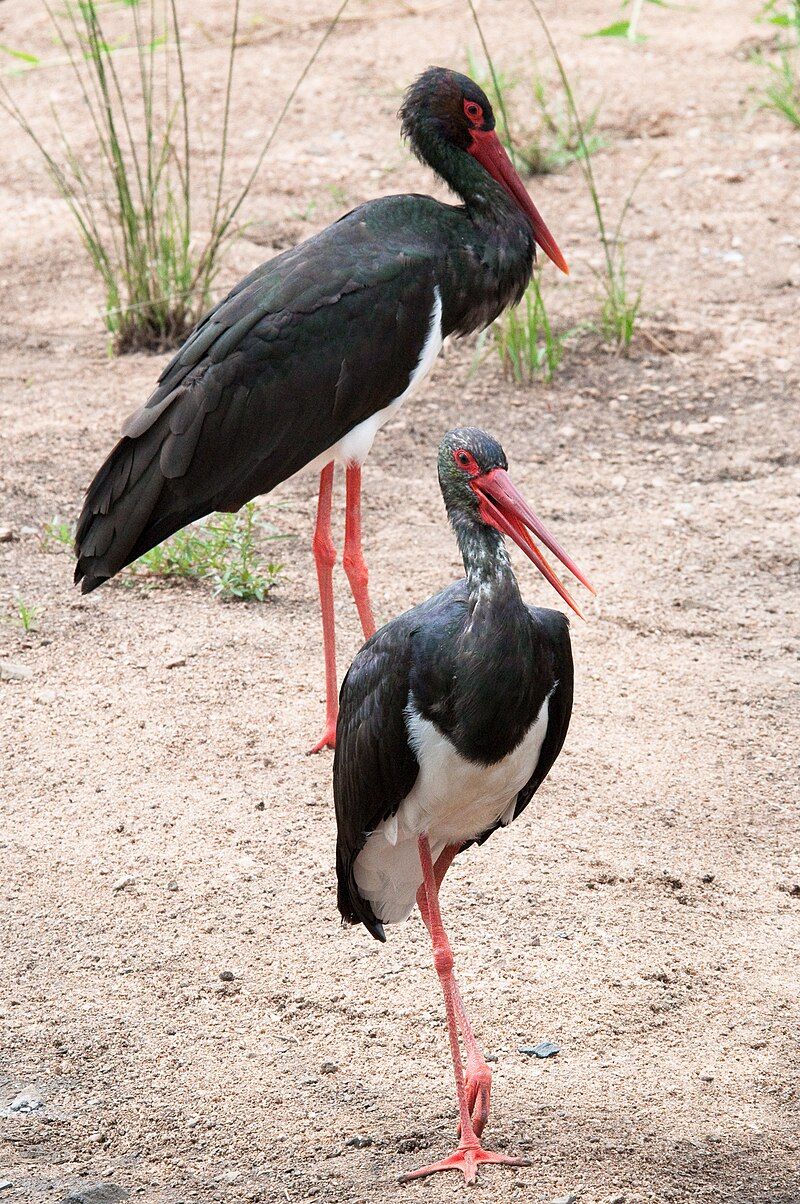
The black stork is a large bird species belonging to the family Ciconiidae. This species was first documented by the renowned Swedish naturalist Carl Linnaeus in the 10th edition of his Systema Naturae.
The black stork stands up to one meter in height with a wingspan of up to two meters. It has a long, pointed black bill, a glossy black plumage, and a white belly. The legs and feet of the black stork are red.
The black stork is found throughout Europe and parts of Asia, inhabiting wetland areas near shallow lakes, rivers, and marshes. It feeds mainly on fish, frogs, and other aquatic invertebrates.
The black stork is a solitary bird usually seen alone or in pairs, although it may form large flocks during migration. It is an endangered species on the IUCN Red List as near threatened.
Conservation efforts are underway in many parts of its range to protect its habitat and ensure its long-term survival.
| Kingdom | Animalia |
| Phylum | Chordata |
| Class | Aves |
| Order | Ciconiiformes |
| Family | Ciconiidae |
| Genus | Ciconia |
| Species | C. nigra |
6. Whooper Swan
The whooper swan, also known as the common swan, is a large bird native to the world’s northern hemisphere. It is one of the largest species of swan, measuring up to 140 cm in length and weighing up to 11 kg.
It is recognizable by its white plumage, black legs, and yellow bill. It is the Eurasian counterpart of the North American trumpeter swan and the type species for the genus Cygnus. The whooper swan is found across Europe and Asia, inhabiting wetlands, rivers, and lakes.
It is a migratory species, breeding in the summer in the northern tundras and then migrating south during winter. It feeds on aquatic vegetation, small invertebrates, and grain crops. The whooper swan is a social bird, often forming large flocks.
It is also a vocal species, producing a distinct honking sound. It is a famous bird in many cultures, often featured in literature and art. It is also Finland’s national bird.
| Kingdom | Animalia |
| Phylum | Chordata |
| Class | Aves |
| Order | Anseriformes |
| Family | Anatidae |
| Genus | Cygnus |
| Species | C. cygnus |
7. Little Grebe
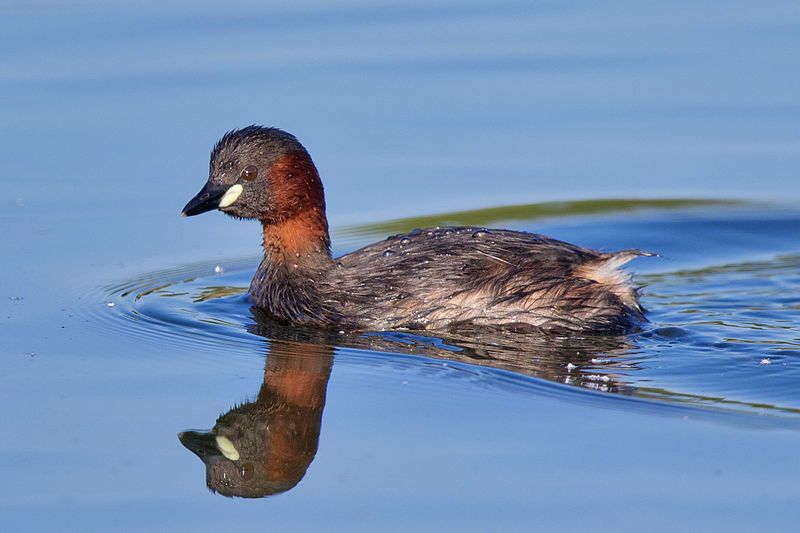
The little grebe, also known as dabchick, is a small bird in many wetland habitats. It belongs to the grebe family, a group of water birds characterized by their webbed feet and diving behavior.
The genus name of the little grebe, “thus,” is derived from Ancient Greek, meaning “fast,” while “bapto,” also from Ancient Greek, means “to sink under.” This describes the little grebe’s ability to dip and dive underwater to feed quickly.
The species name, “ruficollis,” combines two Latin words. “Rufus” means “red,” while “Collis,” derived from the Latin word “collum,” meaning “neck,” describes the bird’s red-colored neck feathers. This combination of Latin words is referred to as “Modern Latin.”
Overall, the scientific name of the little grebe, “Tachybaptus ruficollis,” combines Ancient Greek and Latin words that accurately describe its behavior and appearance.
The genus name refers to its ability to quickly dive underwater, while the species name refers to its red-colored neck feathers.
| Kingdom | Animalia |
| Phylum | Chordata |
| Class | Aves |
| Order | Podicipediformes |
| Family | Podicipedidae |
| Genus | Tachybaptus |
| Species | T. ruficollis |
8. Greater White-Fronted Goose
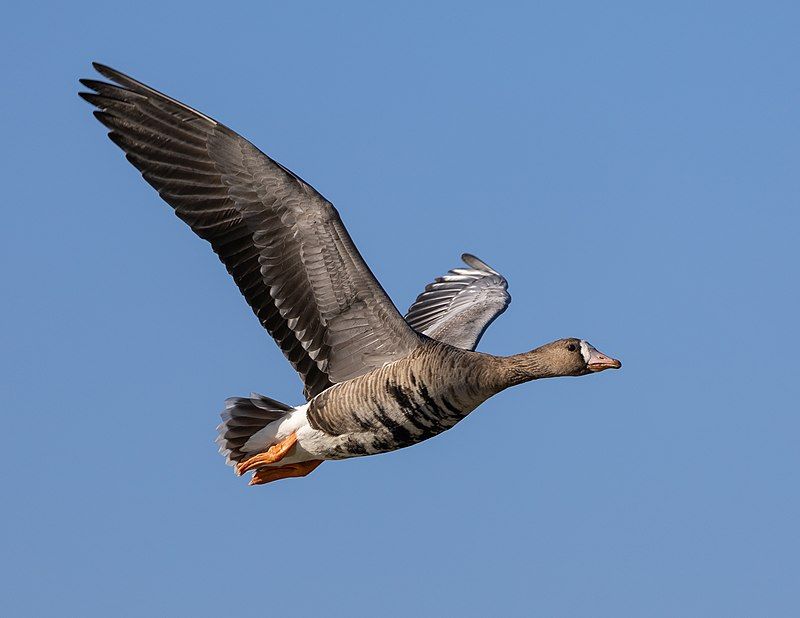
The greater white-fronted goose is a species of goose that is closely related to the lesser white-fronted goose. This goose species is known for its white feathers bordering the base of its bill.
The Latin word albifrons refers to this feature as it translates to albus, meaning “white,” and frons meaning “forehead.”
This white patch on the greater white-fronted goose’s bill is very distinctive and helps to distinguish it from other species of geese. The greater white-fronted goose is a species found in North America and Europe known to migrate between these two continents.
It has a brownish-grey body with black and white wings and a pink bill.
The greater white-fronted goose is slightly larger than the lesser white-fronted goose, with an average length of around 24 inches. The greater white-fronted goose is a species threatened by human activity, as it is often hunted for its feathers and meat.
In addition to this, its habitat is also threatened by human encroachment. The species is listed as near threatened on the IUCN Red List and is protected by the Migratory Bird Treaty Act in the United States.
Reducing human activities in the areas where the geese live and breed is essential to conserve the greater white-fronted goose and its habitat. This can be done by limiting hunting, preserving wetlands, and improving water quality.
Educating people about preserving this species and its habitat is also essential. By doing this, we can ensure that the greater white-fronted goose is around for years.
| Kingdom | Animalia |
| Phylum | Chordata |
| Class | Aves |
| Order | Anseriformes |
| Family | Anatidae |
| Genus | Anser |
| Species | A. albifrons |
9. Hazel Grouse
The hazel grouse, also known as the hazel hen, is a medium-sized member of the grouse family. It is a migratory species, breeding in various parts of the Palearctic region. This includes eastern and central Europe and Hokkaido in the east.
The hazel grouse prefers breeding in dense, damp, and mixed coniferous woodlands, especially those with spruce as a main component. These environments are essential for the hazel grouse, providing shelter and protection for its nesting.
Additionally, the dampness of the environment aids in the development of the young birds, making it an ideal habitat for the hazel grouse. The hazel grouse also benefits from abundant food sources in these habitats, such as berries, insects, and even small mammals.
As a result, the hazel grouse can thrive in these environments.
| Kingdom | Animalia |
| Phylum | Chordata |
| Class | Aves |
| Order | Galliformes |
| Family | Phasianidae |
| Genus | Tetrastes |
| Species | T. bonasia |
10. Eurasian Wigeon
The Eurasian wigeon, also known as the European wigeon, the widgeon, or simply the wigeon, is a species of dabbling duck found in the Palearctic region. It is one of three distinct species in the genus Mareca, which is part of the Anatidae family of waterfowl.
This species is widespread within its range, which extends from Europe to East Asia. The Eurasian wigeon is characterized by its white and gray plumage, with a black head, chestnut-brown breast, and greenish-black bill.
It has a distinctive white patch on the side of its head and white stripes on its wings. It has a white throat and a white-tipped tail, which may be raised during flight. The male has a red patch on its forehead.
This species is found in various habitats, including wetlands, marshes, and shallow lakes. It feeds on aquatic invertebrates, aquatic vegetation, and seeds.
It is often seen in large flocks during migration and sometimes forms large mixed flocks with other species of ducks. The Eurasian wigeon is a famous game bird hunted in many parts of its range.
This species is also a popular choice for waterfowl watchers and birders. Overall, this species is not threatened, and its population is stable.
| Kingdom | Animalia |
| Phylum | Chordata |
| Class | Aves |
| Order | Anseriformes |
| Family | Anatidae |
| Genus | Mareca |
| Species | M. penelope |
11. Red-Crested Pochard
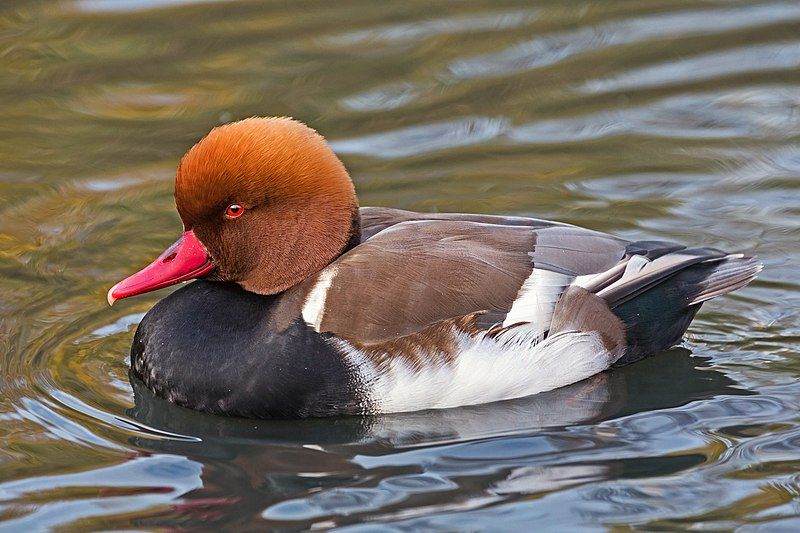
The red-crested pochard is a species of large diving duck. It was given its scientific name, Netta Rufina, derived from two different languages: Greek and Latin. Netta is taken from the Greek word ‘duck,’ while the Latin word ‘Rufina’ means ‘golden-red’.’
This is a reference to the beautiful golden-red plumage of the red-crested pochard. The red-crested pochard is a native species to Europe and parts of Asia. The males of the species have a bright red crest on their heads and a black body with white patches on the wings.
The females of the species are primarily brown, with white patches on the wings. They forage by diving and swimming in shallow waters. They usually feed on crustaceans, mollusks, and aquatic vegetation.
The red-crested pochard is an essential species in the wild, as it plays a vital role in aquatic ecosystems. It is also a popular species among birdwatchers due to its striking beauty.
| Kingdom | Animalia |
| Phylum | Chordata |
| Class | Aves |
| Order | Anseriformes |
| Family | Anatidae |
| Genus | Netta |
| Species | N. rufina |
12. Greylag Goose
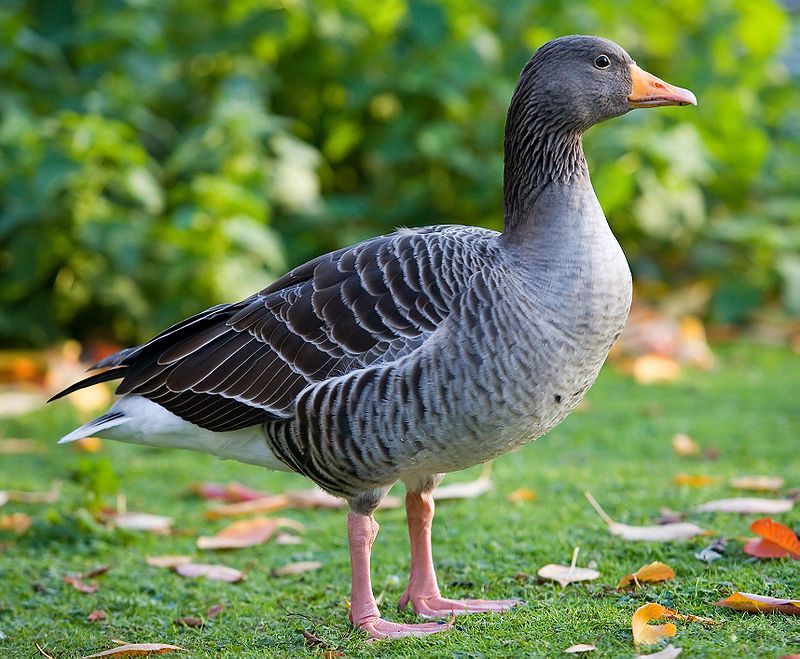
The greylag goose is a species of large goose whose mottled grey and white plumage can be identified. It is part of the Anatidae family of waterfowl and is the type species of the genus Anser.
The greylag goose has an orange beak and pink legs, making it a distinctive waterfowl. It is a common goose species in many parts of Europe, Asia, and North America. It is often seen in wetlands like lakes, rivers, and marshes.
It is a medium-sized species of goose, with an average size of between 17 and 20 inches in length and weighing between 3 and 5 pounds.
The greylag goose is omnivorous, and its diet consists of various things, including grains, insects, worms, crustaceans, and small aquatic creatures. It is also known to consume plant material from marine plants.
The greylag goose is a social species seen in large flocks. During the breeding season, they form monogamous pairs and build a nest on the ground, usually close to water. The female typically lays between 3 and 8 eggs, which are incubated for around 28 days.
The chicks can fly by the time they are around five weeks old. The greylag goose is an essential waterfowl species and an indicator of wetland health. It is also hunted for its meat, feathers, and eggs.
| Kingdom | Animalia |
| Phylum | Chordata |
| Class | Aves |
| Order | Anseriformes |
| Family | Anatidae |
| Genus | Anser |
| Species | A. anser |
13. Grey Partridge
The Grey Partridge is a species of gamebird native to Europe and is part of the pheasant family Phasianidae. It is sometimes called the Gray-legged Partridge, English Partridge, Hungarian Partridge, or Hun.
It is of the order Galliformes, which are gallinaceous birds, and this order includes chickens, turkeys, pheasants, quails, and grouse.
The scientific name for the Grey Partridge is Perdix perdix, derived from the Latin word for “partridge” and the Ancient Greek word for “partridge,” respectively.
The Grey Partridge is a robust bird with a body length of 28-32 cm, a wingspan of 35-43 cm, and a weight of 250-400 g. It has a distinctive gray back, white belly, and a reddish face with white markings on the neck.
Its call is a loud “cackle,” it is an important game bird whose meat is much sought after.
| Kingdom | Animalia |
| Phylum | Chordata |
| Class | Aves |
| Order | Galliformes |
| Family | Phasianidae |
| Genus | Perdix |
| Species | P. perdix |
14. Wood Pigeon
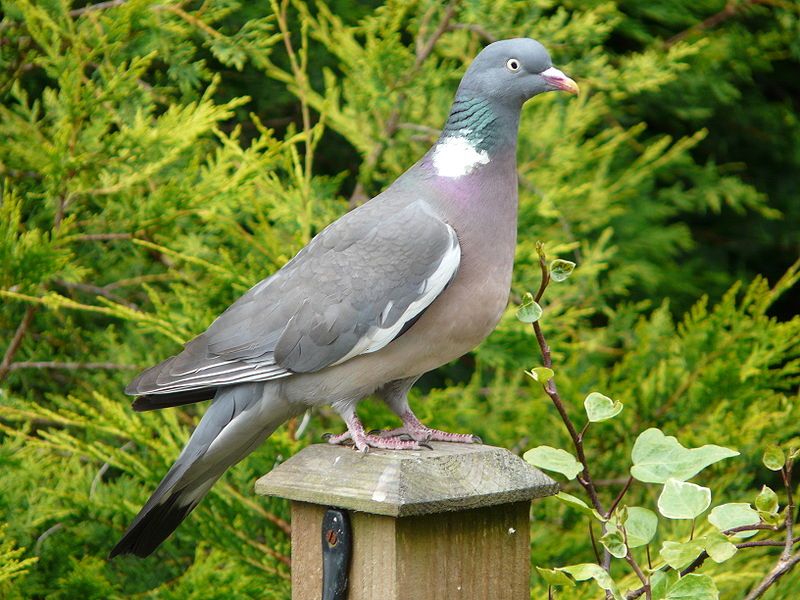
The standard wood pigeon, also known as simply wood pigeon, is a large species of bird in the dove and pigeon family native to the western Palearctic.
This species is found in Europe, North Africa, and parts of Asia and has been introduced to Australia, New Zealand, and the United States. The standard wood pigeon is part of the genus Columba, which includes other closely related species, such as the rock dove.
The standard wood pigeon is easily recognizable due to its size and grey plumage. Its neck and wings have a white patch, while the tail is often a darker grey. The bill is usually yellowish with a red base, and the feet are dark red.
The standard wood pigeon can be found in open fields, parks, and gardens and can often be seen flying in large flocks. It feeds on grains, seeds, and fruits and occasionally on insects and small invertebrates.
It builds a simple platform nest of sticks lined with grasses and feathers and usually lays two white eggs. The standard wood pigeon is an essential game species widely hunted in many parts of the world.
| Kingdom | Animalia |
| Phylum | Chordata |
| Class | Aves |
| Order | Columbiformes |
| Family | Columbidae |
| Genus | Columba |
| Species | C. palumbus |
15. Grebes
Grebes are a type of diving bird found in the order Podicipediformes. They are found in many freshwater habitats worldwide, and some species migrate to marine environments during certain parts of the year.
Most grebes can fly, although some species have become flightless due to living in stable habitats, such as freshwater lakes.
These flightless species are particularly well-adapted to their environment, using their diving skills to forage for food and ensure survival.
Grebes are also known for their elaborate courtship displays, with some species performing elaborate dances to attract a mate. Grebes are an essential part of the aquatic ecosystem, providing food for other animals and helping to keep their habitats healthy.
| Kingdom | Animalia |
| Phylum | Chordata |
| Class | Aves |
| Clade | Mirandornithes |
| Order | Podicipediformes |
| Family | Podicipedidae |
16. Barnacle Goose
The barnacle goose is a goose species belonging to the black geese genus of Branta. This genus is distinguished by its predominantly black plumage, which sets it apart from the species of grey geese, Anser.
These black geese are further classified into several species, including the barnacle goose. The barnacle goose is a migratory species that breeds on the Arctic coasts of northeastern Europe and northwestern Asia.
It winters further south in Europe, from Great Britain to central Germany, east to Ukraine, and southwestern Russia. It is a medium-sized goose with a length of about 65 cm and a wingspan of up to 120 cm.
The plumage of the barnacle goose is black and white, with the white extending down the neck, over the breast, and onto the belly.
The head and neck are black, with a white collar around the neck. The barnacle goose has a vital conservation status, as it is classified as a species of most minor Concern by the IUCN Red List of Threatened Species.
The species is protected under the African-Eurasian Migratory Waterbird Agreement, an international treaty for the conservation of migratory waterbird species.
| Kingdom | Animalia |
| Phylum | Chordata |
| Class | Aves |
| Order | Anseriformes |
| Family | Anatidae |
| Genus | Branta |
| Species | B. leucopsis |
17. Garganey
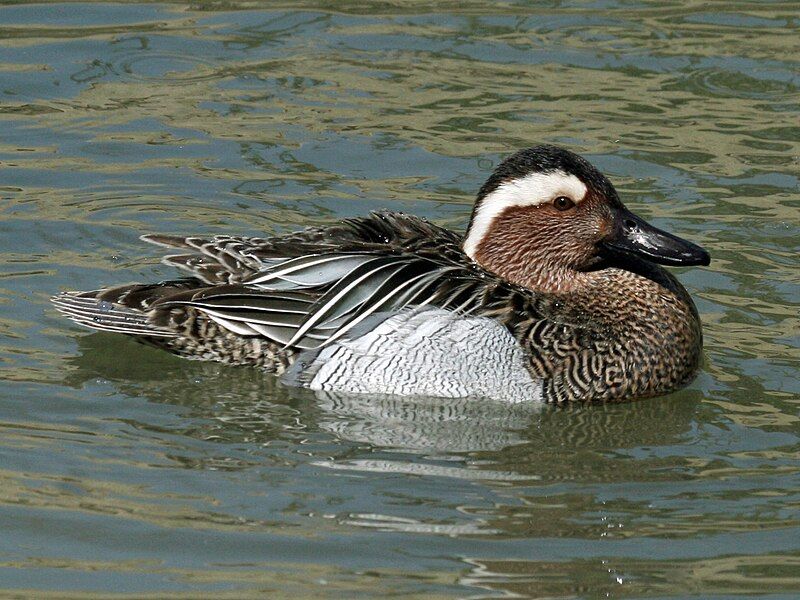
The Garganey is a type of duck found in many parts of Europe and across the Palearctic region. It is a migratory species, meaning its population moves from place to place.
During the winter in the Northern Hemisphere, the garganey population moves south to warmer climates in Africa, India, Bangladesh, and Australasia. In these places, the Garganey can be found in large flocks.
This is likely because the milder climates provide a more suitable habitat for the species to survive the winter.
Furthermore, food availability in these areas is likely higher during the winter compared to the colder months in the Northern Hemisphere.
As such, the Garganey can take advantage of the better living conditions in these areas during the year’s colder months.
| Kingdom | Animalia |
| Phylum | Chordata |
| Class | Aves |
| Order | Anseriformes |
| Family | Anatidae |
| Genus | Spatula |
| Species | S. querquedula |
18. Ferruginous Duck
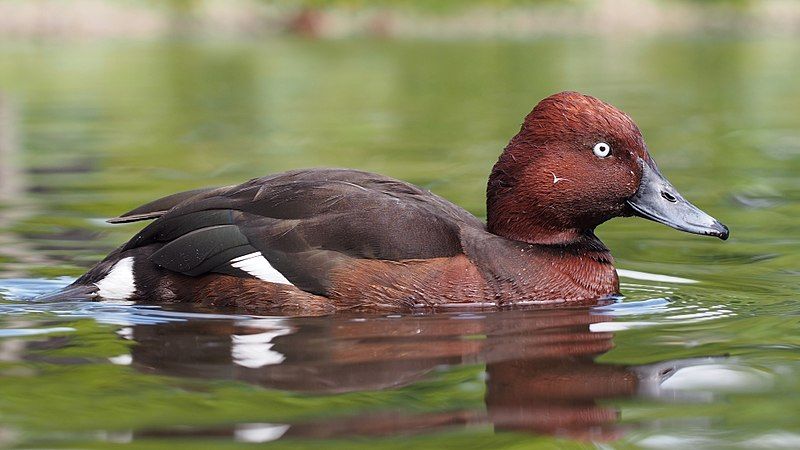
The ferruginous duck is a species of diving duck native to Eurosiberia. Many other names, including ferruginous, common white-eye, and white-eyed pochard, also know it.
The scientific name for this species is Aythya nyroca, derived from the Greek words Lithuania and nyrok. Aithuia is an unidentified seabird mentioned by authors such as Hesychius and Aristotle, and nyrok is the Russian word for a duck.
The ferruginous duck is a medium-sized diving duck, measuring around 50 cm long and weighing between 500-850 g. It has a reddish-brown head and neck, and its chest and back are grey-brown. Its wings are dark brown with lighter edges, and its legs and feet are blue-grey.
The species is found in many habitats, from wetlands to shallow lakes and rivers. It feeds mainly on aquatic vegetation, aquatic invertebrates, and small fish.
The ferruginous duck is an essential species for conservationists, as it is listed as vulnerable on the IUCN Red List. The species is threatened by habitat loss and degradation due to human activities such as agriculture, water abstraction, and pollution.
Conservation efforts are necessary to ensure the species’ survival in the future.
| Kingdom | Animalia |
| Phylum | Chordata |
| Class | Aves |
| Order | Anseriformes |
| Family | Anatidae |
| Genus | Aythya |
| Species | A. nyroca |
19. Red-breasted merganser
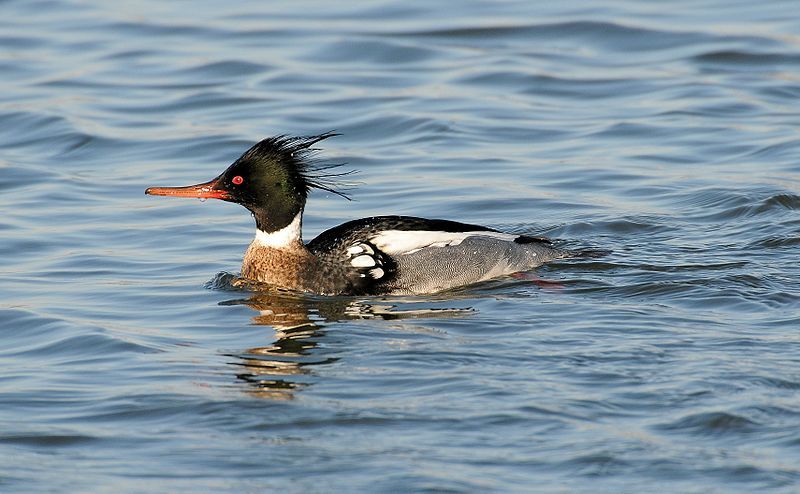
The red-breasted merganser is a species of duck found in many parts of the Northern Hemisphere. It is known for its distinctive red breast, which is only visible on males in breeding plumage.
The red breast is considered an essential factor in courtship and mating rituals in the species. During courtship, males preen their feathers and display bright red chests to attract a mate.
The red-breasted merganser is a large duck, with males reaching up to 24 inches long. The species is an excellent swimmer and has been seen diving underwater to catch small fish. Its diet also includes insects and crustaceans.
The red-breasted merganser is often seen near freshwater lakes and rivers, though it may also be spotted near the ocean. The species is a migratory bird, traveling from its breeding grounds in the Northern Hemisphere to its wintering grounds in the tropics.
The red-breasted merganser is an integral part of the ecosystem, helping to control populations of aquatic species and providing food for larger predators.
| Kingdom | Animalia |
| Phylum | Chordata |
| Class | Aves |
| Order | Anseriformes |
| Family | Anatidae |
| Genus | Mergus |
| Species | M. serrator |
20. Ruddy Shelduck
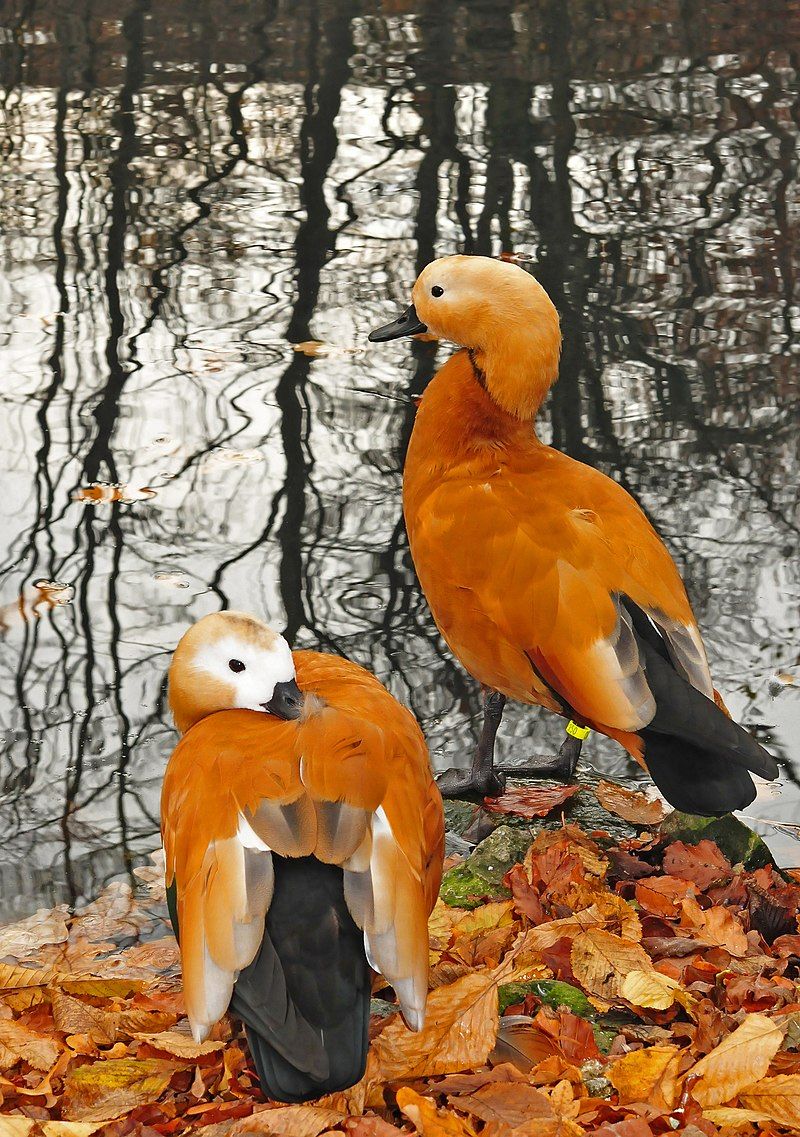
The ruddy shelduck, also known as the Brahminy duck, is a type of waterfowl in the Anatidae family. It is a distinctive bird with a length of 58 to 70 cm and a 110 to 135 cm wingspan.
The most striking feature of the ruddy shelduck is its ruddy-brown, chestnut-colored feathers, which give it its name. Its head is black with a white stripe running from its bill down its neck and a white belly.
The ruddy shelduck can be found in wetlands, lakes, and marshes across much of Eurasia, from the British Isles to Central Asia. It is also found in parts of India, known as the Brahminy duck.
The ruddy shelduck is most commonly seen in pairs or small flocks, and they are known to be exceptionally social birds, often congregating in large flocks in the winter. They feed mainly on plant material, such as grasses and grains, but they also eat insects and mollusks.
The ruddy shelduck is an ecologically and culturally important species in many parts of its range. It is a beloved bird in many cultures and a symbol of good luck in some Native American tribes.
| Kingdom | Animalia |
| Phylum | Chordata |
| Class | Aves |
| Order | Anseriformes |
| Family | Anatidae |
| Genus | Tadorna |
| Species | T. ferruginea |
21. Tufted Duck
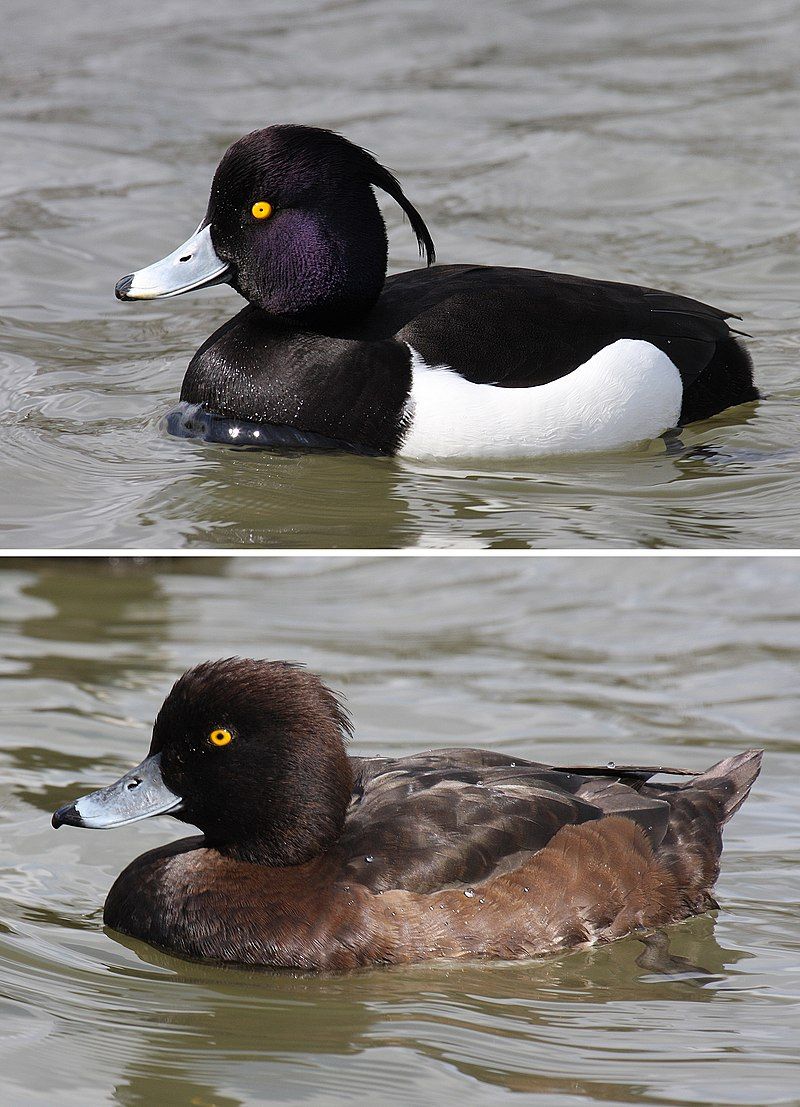
The tufted duck, also known as the tufted pochard, is a small diving duck inhabiting northern Eurasia. It has an estimated population of close to one million birds. The scientific name of this species is derived from Ancient Greek and Latin.
Specifically, the name is derived from the Ancient Greek word Lithuania, which authors, including Hesychius and Aristotle, used to refer to an unidentified seabird. The Latin word ‘Fuego’ means ‘soot,’ and ‘gula’ means ‘throat.’
The tufted duck is widely recognized by its distinctive black, white, and brown plumage and its tuft of feathers on its head. It is a common sight in wetlands, estuaries, lakes, and rivers, where it feeds on aquatic plants, small fish, and other aquatic invertebrates.
The tufted duck is an essential species in the food web of its habitats and is also an important game bird for hunters. Its breeding season is from May to July when the males become especially vocal.
| Kingdom | Animalia |
| Phylum | Chordata |
| Class | Aves |
| Order | Anseriformes |
| Family | Anatidae |
| Genus | Aythya |
| Species | A. fuligula |
22. White-Headed Duck
The white-headed duck is a small diving duck that measures 45 cm long. It has distinct physical characteristics that differ between males and females. The male has a white head with a black crown, a blue bill, and reddish-grey plumage.
For the female, it has a darker bill and a duller color. The white-headed duck prefers to breed in lakes with open water and dense vegetation. This environment provides the duck with ample food and cover from potential predators.
The vegetation at the lake’s margin provides a safe nesting area for the duck to lay its eggs. The dense vegetation also serves as a refuge for the duck while diving for food.
The white-headed duck is an important species in wetlands worldwide, and its conservation is essential. It is vital to protect its habitat so that it can continue to breed and thrive in its natural environment.
Protecting this species will also ensure that other species that depend on the same habitat can survive and thrive.
| Kingdom | Animalia |
| Phylum | Chordata |
| Class | Aves |
| Order | Anseriformes |
| Family | Anatidae |
| Genus | Oxyura |
| Species | O. leucocephala |
23. Common Cuckoo
The common cuckoo is a species of bird belonging to the Cuculiformes order, a group of birds that ding the roadrunner’s couch ls. This species can be seen in Europe and Asia during the summer months when it migrates from its usual winter habitat in Africa.
This cuckoo species is highly adaptable and can be found in various habitats, from woodlands to open countryside.
Its diet consists mainly of insects, but it also eats small mammals, amphibians, and reptiles. The common cuckoo has a distinctive call that can be heard in many parts of Europe and Asia during spring and summer.
The call is loud and repetitive and is usually made by the male to attract a mate.
Cuckoos are also known for laying their eggs in the nests of other birds, such as warblers or finches, which unknowingly raise the young cuckoos as their own.
The common cuckoo is a widespread species among bird watchers, and its distinctive call and behavior make it an exciting bird to observe.
It is also an essential species for conservation, as its presence indicates a healthy and diverse natural environment.
| Kingdom | Animalia |
| Phylum | Chordata |
| Class | Aves |
| Order | Cuculiformes |
| Family | Cuculidae |
| Genus | Cuculus |
| Species | C. canorus |
24. European Turtle Dove
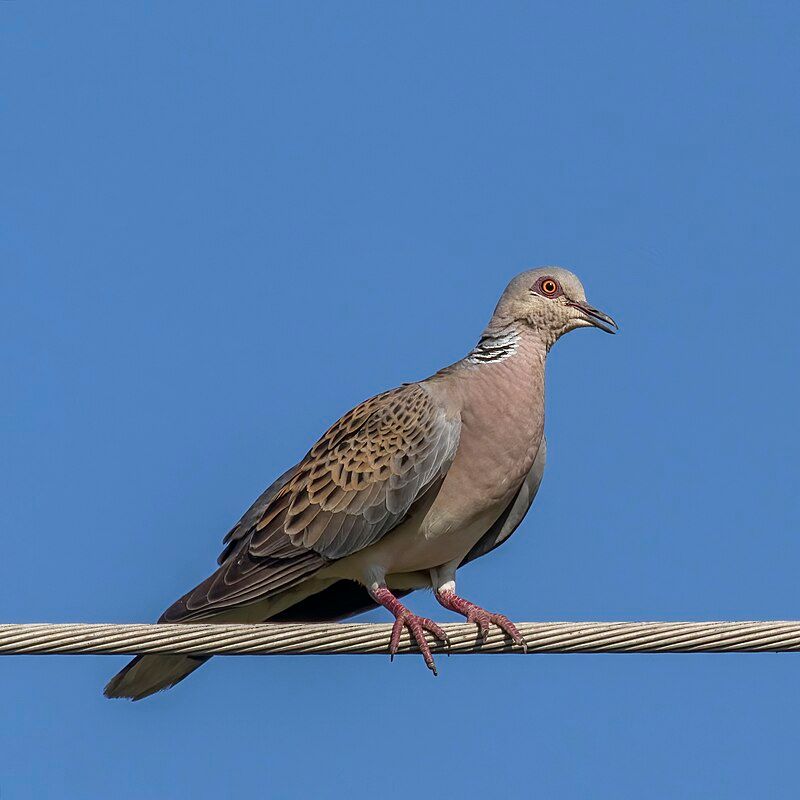
The European turtle dove is a species of bird belonging to the Columbidae family, which includes doves and pigeons. This bird can be found in a vast region of the southwestern Palearctic, from northern Africa to parts of the Middle East and Europe.
During the summer, the turtle dove can be seen breeding in this area, while in the winter, it migrates farther south to northern sub-Saharan Africa. This bird species has a unique ability to travel long distances to find its preferred habitats.
This behavior is typical of many migratory birds. It is a necessary adaptation that allows them to survive and thrive in areas that may not be suitable during certain times of the year.
The European turtle dove is a remarkable species that has evolved to take advantage of seasonal changes and geographical features to find the best environment to survive and reproduce.
| Kingdom | Animalia |
| Phylum | Chordata |
| Class | Aves |
| Order | Columbiformes |
| Family | Columbidae |
| Genus | Streptopelia |
| Species | S. turtur |
Conclusion
Birds in Niedersachsen are diverse and fascinating creatures. From the common species, such as the Great Tit, to the rarer species, such as the White-tailed Eagle, there is something to fascinate bird watchers of all levels.
With its many habitats and protected areas, Niedersachsen is a great place to observe these beautiful creatures in their natural environment.